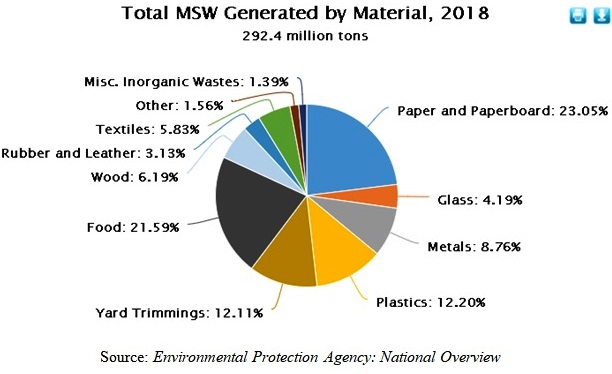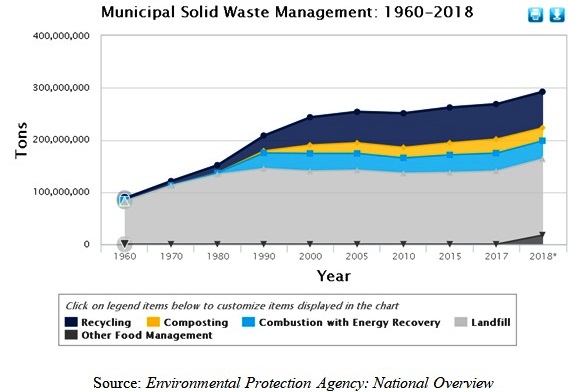Packaging is one of the biggest influences on the world’s sustainability. It is an area of science that requires further improvement to ensure a sustainable future. This paper will aim to help people better understand packaging and sustainability by discussing current waste management techniques, methods that are currently being developed to improve packaging, and current issues in packaging. The limiting of excess packaging waste will be achieved through a combination of recycling, reducing packaging waste, changing the laws to fiscally favor greener packaging materials, and the development of sustainable materials. The following information will work to inspire people to dedicate their careers to making sustainable packaging.
Ever wonder what happens to packaging material once it is put in the garbage? According to Bulk Bag Reclamation, packaging waste accounts for 65% of household trash (What Is Green Packaging). From there it is taken to a landfill where trash is spread out and soil is placed on top before being compressed. This process is completed countless times until you have a landfill with trash and soil layers covering a large portion of the ground. Landfills are currently the most common method for waste disposal. In fact, 90% of solid waste in the United States ends up in a landfill, despite 80% of the items being buried in landfills having the possibility of being recycled (Rubicon). A figure for the different materials that can be recycled is shown below.

The problem with landfills is that they cause 80% of the worlds soil pollution. Soil pollution is bad because it makes life uninhabitable to humans and the ecosystem. The toxic chemicals in the ground make landfills uninhabitable for hundreds of years. This is an entirely avoidable problem since, as previously mentioned, 80% of the items being buried in landfills have the possibility of being recycled (Rubicon). This means a significant portion of the soil pollution could be reduced by increasing the rate of trash we recycle.

There are, however, methods to reduce the amount of Municipal Solid Waste being caused by packaging materials. In fact, the Environmental Protection Agency has set fourth several plans to limit waste known as the Waste Management Hierarchy. The figure below shows a range of the most important topics listed in order by their overall contribution to the ecosystem.

The biggest issue with packaging sustainability is that even though efforts have been made to recycle, most people are consuming more packaging than previous generations. Large portions of packaging waste could be eliminated by simply consuming less packaging, switching to a more permanent option, and eliminating disposable items from their everyday use.
While every country would benefit from reducing excess packaging waste, the United States would see the biggest changes in improving their waste management criteria. The United States shares a disproportional amount of responsibility for unsatisfactory packaging practices. According to the University of Southern Indiana the United States shares the Bulk of the blame for packaging waste. Despite the United States only having 5% of the world’s population, they generate 40% of the world’s waste (Solid Waste & Landfill Facts). This means a key problem is people using a disproportional amount of packaging when compared to the rest of the world. When you consider how prevalent Amazon packages are in the United States, and how many times you have received a box that is far bigger than the item inside, this generated unnecessary waste.
While in a perfect world we would hope for people to take it up amongst themselves to reduce the amount of waste they contribute. A far better approach is to tax companies for damages made to the planet for excess packaging waste. This is a better solution for reducing the amount of packaging used because it ensures no matter what ends up happening sustainability is ensured. If companies do not reduce the amount of packaging contributing to sustainability damages, they will have to pay a fine that would be put towards decreasing packaging waste. Either case helps diminish the amount of packaging waste taking its toll on the ecosystem. Right now, a big problem with sustainability is the types of materials we use have a low upfront cost, but a large secondary cost to the ecosystem. While it may be less expensive to use plastic to package items over biodegradable materials, plastics will lead to long term problems in sustainability. By forcing companies to take responsibility for the secondary ecosystem cost we can eliminate much of our sustainability problems and make it more economically feasible for companies to embrace the use of biodegradable material.
While at first glance it may not seem moderate changes in reduction can have a noticeable impact it is important to remember even a moderate improvement in waste management and material packaging selection could have profoundly positive effects on the earth’s ecosystem. This is because the usage of non-biodegradable materials has long lasting effects on soil contaminations. In fact, it takes an average of “500 years for average sized plastic water bottles to fully decompose” (Rubicon). For reference, the United States has only been a country for 250 years, making the span of life of a plastic twice as big as the entire United States history.
This is one of the many reasons recycling must be made easier and enforced to follow. Recycling has the added benefits of saving energy and creating less air pollution. For example, “a single recycled plastic bottle saves enough energy to run a 100-watt bulb for 4 hours. It also creates 20% less air pollution and 50% less water pollution than would be created when making a new bottle” (Rubicon). This means that through recycling we can save energy and reduce air pollution. Another hurdle to uncover on our path to becoming a more sustainable society is that even though we have greatly increased the amount recycle, composted, and combust into energy, we have also increased the amount of Municipal Solid Waste. The figure below shows even though we have greatly improved our recycling capabilities, we have also increased our overall waste output. The graph also clearly demonstrates without decreasing the amount of packaging waste being used, the overall effects of recycling have been overshadowed by the amount of waste produced.

Politics could also pay a key role in improving the sustainability of packages. For example, have you ever noticed that plastic Dasani Bottles and Fiji Bottles are much thicker than a standard grocery brand water bottle? This is done to give water bottles a higher quality feel, despite there not being an advantage to having a thicker bottle. The thicker water bottle further contributes to sustainability problems just to make it easier to make their brand. While the examples listed were water bottles, this system is widely used by soda companies to increase their profits. To help reduce packaging waste there should be more regulations on the plastics produced. A good option would be to pass a law requiring a maximum thickness for any disposable bottles. This will limit the amount of unnecessary waste and cause a dip in soft drink sales and would help people live a healthier lifestyle.
The third step in the waste management hierarchy is Energy Recovery. According to the EPA energy recovery form waste is “the conversion of non-recyclable waste materials into usable heat, electricity, or fuel through a variety of processes, including combustion, gasification, pyrolization, anaerobic digestion and landfill gas recovery” (EPA). This means that packaging material can be used to provide energy to the world by combusting waste.
To convert waste into energy, the waste must go through the Mass Burn Process. In this process municipal solid waste is sorted into different piles with a crane. After the waste is sorted, a crane lifts the waste into a combustion chamber. The combustion chamber converts water into steam, which is used to power a turbine generator to produce electricity (EPA).
If this process seems like it could have unintended consequences to the environment, you are right. According to the EPA “Combustion of MSW grew in the 1980s. By the early 1990s, the United States combusted more than 15 percent of all MSW. The majority of non-hazardous waste incinerators were recovering energy by this time and had installed pollution control equipment. With the newly recognized threats posed by mercury and dioxin emissions, EPA enacted the Maximum Achievable Control Technology (MACT) regulations in the 1990s. As a result, most existing facilities had to be retrofitted with air pollution control systems or shut down” (EPA). While the threats to the environment were eventually minimized it is important to remember to consider any unintended effects when deciding future plans for sustainability.
A topic not discussed in the Waste Management Hierarchy is the development of new packaging material. The type of materials used in packaging plays a key role in increasing sustainability. By switching to an alternative packaging material, we can reduce much of the unnecessary packaging waste. In recent years there have been tremendous strides in packaging material technologies.
One improvement in packaging technology has been the adoption of air pillows made from recycled materials instead of using Styrofoam or bubble wrap. Recycled pillows have the added benefit decreasing the overall amount of plastic used, while keeping the price of packaging low. This small change has had a drastic effect on the needed output of plastic and reduced the amount of plastic necessary by a considerable margin.
Another big advancement to packaging made in the last few years has been the development of Cornstarch Packaging. Cornstarch packaging is an environmentally friendly alternative to plastic. It is made from corn and maize plant and is completely biodegradable. Cornstarch packaging has similar properties to packaging, which means it can be used in a wide variety of applications that have traditionally used plastic. These involve items from bottles to molded forms and loose-fill packaging. Currently the biggest issue with cornstarch packaging is that it takes up needed crops from animals and humans. This means for a sustainable future we will have to increase the corn production amount to meet the dietary and packaging needs.
The final advancement done to packaging in recent years comes from an unlikely friend, Marijuana. Hemp packaging is packaging made from the marijuana plant. It had its name changed to help the adoption of the packaging material, but it does come with added benefits. While traditional fossil-fuel based packaging takes one thousand years to decompose, hemp packaging only takes six months to decompose. This will greatly alleviate the current strain from traditional plastics on the environment. The biggest challenge associated with the adoption of hemp stems from the legal issues associated with the plant.
In conclusion, the limiting of excess packaging waste will yield the best results through a combination of recycling, reducing packaging waste, changing the laws to fiscally favor greener packaging materials, and the development of sustainable materials. If we were able to reduce the municipal solid waste back to previous generations levels, change laws to fiscally favor green packaging, and change to a more sustainable packaging material we would see a big improvement in the environment. These are changes that would lead to a more sustainable future and help reduce soil pollution for literally a millennium. The future of sustainability will come in large part to an improvement in our packaging equipment.
References
Bulk Bag Reclamation (2020, August 27). What Is Green Packaging: Benefits of Using Green Packaging. Retrieved November 14, 2020, from
https://bulkbagreclamation.com/what-is-green-packaging/
Clean Air Council. (n.d.). Scary Facts About Landfills. Retrieved November 14, 2020, from http://www.green-rebuild.com/scary-facts-about-landfills.html
EPA. (2020, July 31). Energy Recovery from the Combustion of Municipal Solid Waste (MSW). Retrieved November 14, 2020, from
https://www.epa.gov/smm/energy-recovery-combustion-municipal-solid-waste-msw
National Overview: Facts and Figures on Materials, Wastes and Recycling. (2020, March 13). Retrieved November 14, 2020, from https://www.epa.gov/facts-and-figures-about-materials-waste-and-recycling/national-overview-facts-and-figures-materials
Rubicon .50 Recycling & Trash Statistics That Will Make You Think Twice About Your Trash. (2020, September 28). Retrieved November 14, 2020, from https://www.rubicon.com/blog/statistics-trash-recycling/
University of Southern Indiana, U. (n.d.). Solid Waste & Landfill Facts. Retrieved November 14, 2020, from https://www.usi.edu/recycle/solid-waste-landfill-facts/


































